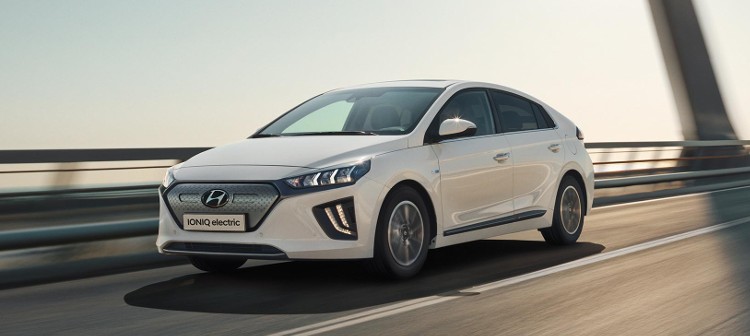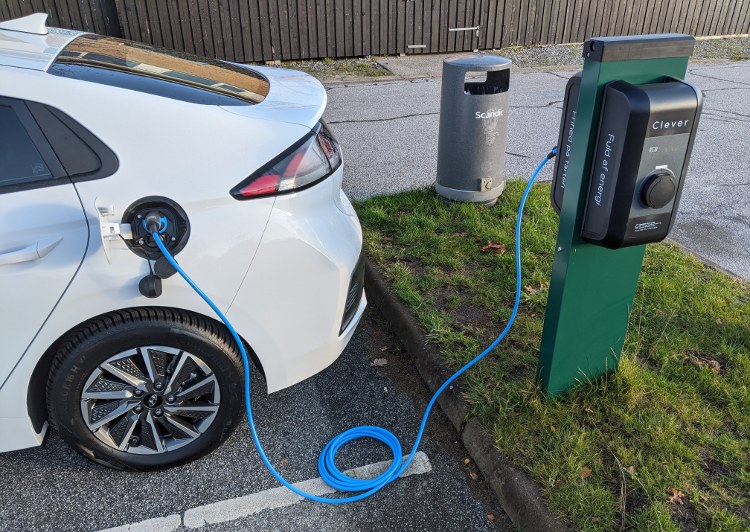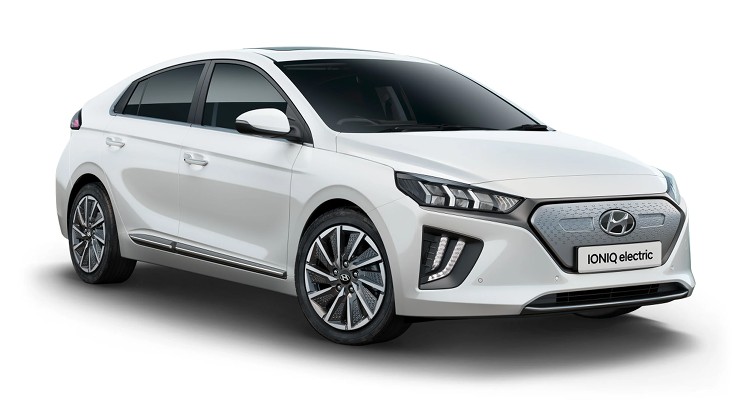
In late 2020 we decided to get a car. After relying on the extensive Danish public transport system for many years, it was time for a “socially distanced” means of transportation. My friend Jon had just got a Hyundai Kona Electric — a mini-crossover with good range. This sparked my interest in electric cars, and after a month of research and testing, we ordered its sibling, the 2020 IONIQ Electric. It’s a frugal yet fun car with good value but some drawbacks.
Range and Efficiency
The Hyundai IONIQ is a fairly normal small family car, except of course that it’s electric. The first thing people want to know about an electric vehicle (EV) is the range. In my opinion, charging speed is at least as important as range but we’ll get to that in a bit.
The rated range is 311 km (193 mi) according to the WLTP standard. However, the WLTP can be optimistic for the Danish climate, and having a single “combined driving” range number in your head can lead to disappointment when you travel by motorway/highway — which is where range often matters the most.
Driving an EV makes you more aware of the factors that affect efficiency: Speed, temperature, weather, tires, weight, aerodynamics, etc. Even though these affect regular internal combustion engine (ICE) cars as well, you’re just more likely to notice them in an EV. Here’s how much it matters:
Driving at 130 km/h (~80 mph) on a dry road just below freezing, with the heat cranked up, I got:
- 4.3 km/kWh (2.7 mi/kWh) or 23 kWh/100km (37 kWh/100mi), or
- 38 km/L (89 MPG US) or 2.6 L/100km in fuel equivalents, or
- 165 km (102 mi) estimated range
Driving at 80 km/h (50 mph), and slowing down for the occasional town, in 9°C (48°F) gave:
- 8.8 km/kWh (5.5 mi/kWh) or 11 kWh/100km (18 kWh/100mi), or
- 78 km/L (183 MPG US) or 1.3 L/100km in fuel equivalents, or
- 337 km (209 mi) estimated range
Notice the amazing efficiency. While the Hyundai IONIQ’s range is not fantastic, its efficiency is. It was in fact the world’s most efficient production car, before the Tesla Model 3. But even so, range depends heavily on speed and weather. I have not yet tried the car in the summer but I expect to get 250 km (155 mi) of range on the Danish motorways at 110–130 km/h (~70–80 mph).
For short/city trips, the IONIQ is great. It’s snappy, quiet, and clean, and I never worry about range, only charging it once or twice per month. But for long trips, charging speed is at least as important as range, and the 2020 IONIQ’s fast-charging speed is unfortunately not especially good — a trait shared with most of the least expensive EVs.
Charging Basics
EV charging is complicated, compared to the ol’ gas/petrol fill-ups. Charging speed varies by a great deal, depending on the power that the charging station will deliver and the power the car will accept. The power that the charging station can deliver can roughly be classified into home/destination (AC) charging which takes hours and (DC) fast-charging which takes minutes. The power that the car will accept is governed by the car’s battery management system, and depends on the exact battery technology used in the car, but also on the state of charge of the battery (fullness percentage), and even the battery temperature.
Fast-Charging
For long trips, a big battery with a long range is nice for the first leg of the trip if you start off fully charged. But after that, the big battery is not of much help if it takes a long time to charge. It would be faster overall to have a smaller battery that charges quickly. The best is of course a big battery that charges quickly.
Charging speed is generally expressed in kW (kilowatts a.k.a. kilojoules per second), but another useful metric is km/h or mph, as in “how much range can I add in one hour of charging”. This makes it easy to compare vehicles with different battery sizes and efficiencies, based on some combined driving style.
According to the EV Database, the 2020 Hyundai IONIQ will charge at 210 km/h (130 mph), when connected to a 50 kW fast-charger — that is, a charger that will deliver as much power as the car wants, up to 50 kW. This charging speed is comparable to that of a Chevrolet Bolt, Renault Zoe, or Nissan Leaf (small battery). While 210 km/h (130 mph) is fast as a driving speed, it’s not a crazy charging speed. In case of the IONIQ it means spending 50 minutes to charge it from 10% to 80% state of charge. (The slow charge from 80% and up is typically reserved for home/destination charging.) Taking a break once in a while is a good thing, and 50 minutes can be a nice food break on a roadtrip. But many breaks only need to be short, and with the 2020 IONIQ, up to a third of your time will be spent charging on long trips.
More expensive EVs will be able to accept charge at a faster rate. Everything over 300 km/h (~185 mph) also requires faster charging stations providing from 75 kW up to 350 kW, which may be rarer than 50 kW stations. Around 400 km/h (~250 mph) charging speed we find cars such as Ford Mustang Mach-E, the long range versions of Nissan Leaf and Hyundai Kona, and, ironically, the older 2016–2019 Hyundai IONIQ with a smaller battery. Further up we have the Polestar 2 and the top versions of Volkswagen ID.3 and ID.4, and Skoda Enyaq. Even further up we have Audi, Porsche, and Tesla. The upcoming IONIQ 5 crossover should be able to compete at the top, at up to 960 km/h (~600 mph) charging speed.
At the moment, many EVs are great city cars, but only some are great for long distance. Or rather, they have the potential to be great, if paired with good charging infrastructure — this is a topic for another time. I expect to post an update when I get more personal experience with longer trips. Also note that while the IONIQ’s charging speed is not great, the car is fully capable of long trips, and has a good range for the price. More city-oriented EVs have shorter range or will be pushed to their limit at highway speeds.
Home/Destination Charging

Home or destination charging is slower, but just like fast-charging, available power vs. receivable power applies. The slowest form of charging is trickle charging using an ICCB (In-Cable Control Box) cable. All EVs are slow charging with this type because power is limited by supply rather than demand. A household outlet might supply at most around 2 kW and should only be used for prolonged periods in emergencies or if the outlet has been properly installed for it. Slightly faster are the few CEE camping outlets that our municipality have installed for public use in the city, where I get 2.6 kW. At this speed, a full charge of the Hyundai IONIQ’s 38 kWh battery from 0% to 100% takes 17 hours. Cars with bigger batteries will take proportionately longer.
Proper home/destination wallboxes, like the one in the picture above, typically supply 11 kW using three phases. This is the market standard, and what many EVs will accept. For example, the long range versions of Hyundai Kona or Tesla Model 3 will take 7–8 hours for a full charge, and often less, because you don’t run the battery down to empty every time (or ever). A few cars, such as the Renault Zoe, will slurp up 22 kW if the wallbox can supply it.
The Hyundai IONIQ with its single-phase charger is unfortunately more limited. I might explore this in a future post, but in practice I get only 3.5 kW out of an 11 or 22 kW wallbox, and a full charge takes 13 hours. As with fast-charging, the 2020 IONIQ is slow. On the other hand, home or destination charging doesn’t need to be fast, unless you drive a lot. There’s more interesting stuff about charging such as parking, prices, economy, etiquette, reliability, and the availability of chargers for people like us who live in an apartment, but for now I want to talk about the car itself.
Driving the Hyundai IONIQ Electric
As with many EVs, the best part about driving the Hyundai IONIQ is the acceleration. Known as instant torque, an electric motor supplies high torque from low RPMs whereas an internal combustion engine (ICE) needs high RPMs for high torque. It also reacts quickly to pedal input, and has no downshifting delay or turbo lag. Even though it is a modest car with “only” 100 kW (134 BHP) and a 9.7 second 0–100 km/h (0–62 mph) time, it is still pretty fun in the city. At medium speeds like 30–70 km/h (~20–45 mph), flooring the accelerator will push you back in your seat. It’s no Tesla, but it makes me smile.
At low speeds the acceleration does not feel quite as strong for some reason, but it can still leave regular city drivers behind when the stop light turns green, all without making noise. At highway speeds of 110 km/h (~70 mph) and up, the acceleration feels fairly average. More powerful EVs will still be snappy at high speeds, and of course extremely snappy at low speeds. Compared with similarly priced EVs, the IONIQ has a high top speed of ~180 km/h (~110 mph), probably thanks to its good aerodynamics. The car feels very stable on the road, but the suspension feels too firm for a family car, and I need to go over speed bumps quite slowly.
Braking
One of the advantages of electric cars, including hybrids, is that braking turns the kinetic energy back into usable electrical energy instead of losing it as heat. In the IONIQ, like in most EVs, the brake pedal will regenerate power using the motor when pressed lightly, and only apply the disc brakes when pressed hard. In between the two is a transition that works pretty well.
Power regeneration, and therefore braking, also occurs when letting go of the accelerator pedal, with the level of regen being configurable in the IONIQ. The default setting feels exactly as how I remember driving an automatic transmission ICE car, but it is possible to both lower and increase the regen from that. Level 0 is like coasting in Neutral, except pressing the accelerator still speeds up the car. Level 1 is the default mild regen. Levels 2 and 3 get you into one-pedal driving territory.
In one-pedal driving, the accelerator transitions smoothly between full acceleration and medium braking, with the brake pedal and disc brakes only required for emergency braking. Unfortunately, the IONIQ, like older Teslas, does not brake all the way down to a standstill when you release the accelerator, and so I still use the brake pedal at stop lights. The Nissan Leaf, and newer Teslas, allow for complete one-pedal driving all the way down to zero. (As an aside, Tesla separates itself from other EVs in that the brake pedal does not regen, and apparently, the newest Teslas can only do one-pedal driving — no coasting.)
Noise and Sound
I love the ability of an EV to accelerate quickly without making noise. In fact, every time I hear a loud car or motorcycle in the city I realize how considerate EVs are to other people. In mean, please have fun in your sports (ICE) car, but please do it somewhere else. Even the majority of normal people in normal ICE cars produce a background level of noise in the city that is detrimental to our health — like the emissions.
While I like the lack of noise, the IONIQ can be too quiet. It is actually equipped with a loudspeaker for its VESS “Virtual Engine Sound System” which makes a sci-fi humming sound to alert pedestrians, but it’s just not very loud. We live on the Aalborg waterfront where pedestrians often walk in the middle of the street and the less observant pedestrians will not hear the car when I approach from behind. I patiently wait behind them but it would sure be nice to have a volume knob for the VESS.
While reversing, the VESS plays a distinct and louder “ding” sound. Again, I’d prefer just having a louder hum but at least the ding is noticeable. In fact so much that I usually turn it off when parking at night, as the ding can be heard from inside nearby apartments. It’s not as loud as an ICE, but different.
The inside of the car is quiet at low speeds, but somewhat noisy on the highway due to wind and rolling noise. More expensive cars will have more sound insulation, but you can’t get everything in an economy car.

Practicality and Features
The good efficiency of the IONIQ comes in part from its good aerodynamics — not just a low drag coefficient, but a low cross-sectional area as well. The car is 145 cm (4’9”) tall and that has a few disadvantages. The sloping liftback roofline means that the back seat does not have a lot of headroom. Even in the front, with the driver’s seat lowered all the way down, my big lockdown hair sometimes touched the ceiling until my recent haircut (I’m ~188 cm (6’2”)). The rear window does not have great visibility, and there’s no rear windshield wiper.
The charge port is located on the side of the car like a regular fuel door which is a bit annoying since many public chargers in Denmark seem to expect you to charge from the front of the car. Actually, it’s probably more correct to say that the charging stations are annoying.
The IONIQ includes plenty of tech such as automatic lane keeping and emergency braking, adaptive cruise control, keyless entry and start, Android Auto and Apple CarPlay, heat pump, heated side-view mirrors, heated seats, heated steering wheel, parking sensors front + back, backup camera, etc.
Like probably a lot of other new cars it also has a touch screen that doesn’t work with gloves (presumably a capacitive touch screen). At least the climate control “buttons” below the touch screen work with gloves (presumably resistive touch buttons). Thankfully, the steering wheel buttons are old-school push buttons (unlike in the Volkswagen ID.3 and ID.4).
On and Off
The IONIQ is built on a platform that includes a hybrid and a plug-in hybrid version, and this makes it feel “last gen” compared to cars built on pure EV platforms. Among other things because it uses the old on/off paradigm:
- Get in
- Turn car on
- Switch to Drive
- Drive
- Switch to Park
- Engage parking brake
- Turn car off
- Leave car
The key is wireless and the parking brake will disengage automatically in Drive, but it’s still more steps than is necessary. It’s especially easy to forget to turn the car off after use because there’s no motor noise/vibration to make you feel that it’s on. And if (when) you do forget, the IONIQ lets out a prolonged, piercing beep when you close the door from the outside. Instead, a simpler and friendlier sequence would be:
- Get in
- Switch to Drive
- Drive
- Switch to Park
- Leave car
The Volkswagen ID.3 and ID.4 work like this, except even switching to Park is optional — it will automatically apply the parking brake when you open the door, and turn off when you leave.
Conclusion
Overall, the IONIQ Electric is a nice car. It’s fantastic for city use, and unlike cheaper EVs, it’s fully capable of long trips — as long as you are patient when charging. If long trips are only occasional it is still a good EV for the price. The best value would be if you have your own home charger and a medium long daily commute. But in the end, charging speed is the 2020 IONIQ’s Achilles’ heel when it comes to using the car as your only or primary car.
A Tesla Model 3 SR+ would be bigger and better in range, acceleration, and charging speed, but it would also cost 75% more to purchase in Denmark. In between the IONIQ and Model 3 are some good options though: Peugeot e-208, Hyundai Kona, Nissan Leaf e+, Volkswagen ID.3, Volkswagen ID.4, and Skoda Enyaq. The upcoming IONIQ 5 and its sister Kia EV6 also look very interesting. In general, the future is set to bring a lot of exciting development in EVs.
If you want to know more about EVs I can recommend the YouTube channel of Bjørn Nyland for car reviews and tests, and Plug Life Television with more background info on charging, economics, society, and the environment, as well as some beautiful EV roadtrips. Also check out Fully Charged Show including their EV beginner’s guides.